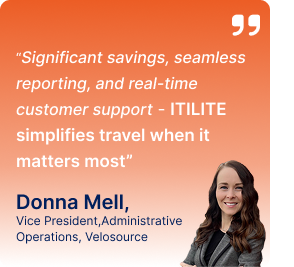
The travel industry is a constant dance with change. Staying ahead requires agility: listening to traveler needs, spotting trends, and embracing new tech. Train your team, craft smart ad campaigns, and foster a culture of continuous learning. It’s the recipe for success in this dynamic landscape.
In a complex world, change is often necessary. However, about 66% of change initiatives fail, and only 34% succeed. Effective corporate travel change management starts with understanding the “why” behind the shift. Is it to cut costs, improve traveler experience, or adapt to new technologies? Analyze the data—what are the root causes of inefficiencies, and how will the change benefit the company? Assess your team’s readiness—are they open to new ideas?
The next step? Define your vision and goals. Clearly communicate why the change is crucial and how it will improve travel program performance. Setting SMART goals—Specific, Measurable, Achievable, Relevant, and Time-bound—keeps everyone focused. Frameworks like the Balanced Scorecard can help track progress. Remember, successful change management is a two-way street.
Change Management in Business Travel: Friend, Not Foe
A Google search on “change management” explodes with generic theories for massive corporate transformations. In business travel, “change management” can trigger groans or excitement. It’s a coin toss – some see it as a necessary evil, others as a chance to revamp. Here’s the truth: 70% of change efforts fail [according to McKinsey].
But why? Change is scary because of the unknown, not the process itself. You might be comfortable with the current corporate travel program, even if flawed. But sticking with a broken system won’t solve long-term problems!
Let’s flip the script! Don’t dwell on the negatives. Focus on the positive outcomes of corporate travel change management: streamlined processes, cost savings, better visibility into spending, improved traveler satisfaction, and increased sustainability.
Focus on the Upside:
- Streamlined Processes: Forget outdated methods and save time
- Cost Savings: Identify areas where you can give results
- Greater Visibility: Gain control over your travel program
- Reduced Leakage: Stop money slipping through the cracks
- Happier Professional Travelers: Provide a smoother, more efficient experience
- Sustainability: Be part of the solution for a greener travel future
Change management in business travel isn’t about negativity; it’s about unlocking a brighter, more efficient future for your program. Let’s check out the 5 major things to know in change management, not fear the unknown.
How will you Motivate your Corporate Team to Embrace Change Management?
In the US business environment, motivating an existing corporate team to adopt a closed-managed booking system for corporate travel requires a multi-pronged approach that addresses their concerns and highlights the benefits. Here are 4 tactics to consider:
- Focus on Benefits, Not Restrictions: Present closed-managed bookings to streamline processes, not restrict freedom. Emphasize the potential for significant cost reductions through negotiated rates and better budget control, which can directly impact the company’s bottom line. You can highlight benefits like:
- Cost Savings: Negotiated rates, volume discounts, and control over spending.
- Reduced Risk & Compliance: Ensure adherence to company policies and travel restrictions.
- Improved Efficiency: Centralized travel booking reduces time spent searching and comparing options.
2. Showcase Improved Efficiency:
- Demonstrate how managed bookings streamline the travel process.
- Reduce last-minute changes.
- Minimize administrative burdens, allowing employees to focus more on their core responsibilities.
It’s natural for employees to worry about losing control or flexibility when a new system is introduced. Acknowledging these concerns and explaining the benefits clearly and openly is necessary. Show them how the closed-managed booking system actually empowers them to focus on their work during travel rather than restricting their freedom.
3. Pilot Program & Training: Pilot the new system with a small group first to gather feedback and address initial challenges. Provide comprehensive training on how to use the closed-managed booking system and its functionalities.
4. Incentivize Adoption: Consider offering incentives for early adopters to encourage participation and positive word-of-mouth within the team. This could be rewards, priority booking access within the system, or recognition programs.
Strategies for Change Management for Managed Business Travel Bookings (closed travel bookings) in the US
Shifting from open to closed business travel bookings (managed programs) requires a well-defined change management strategy. Here’s a breakdown of 5 things you should do in change management in business travel bookings.
1. Understanding Needs
- Define Goals: Clearly articulate the reasons behind the change. Is it about cost reduction by leveraging negotiated rates with preferred vendors? Is it to improve duty of care by ensuring traveler safety and security? Compliance with company policies or industry regulations is a driving factor.
- Identify Stakeholders: Create a comprehensive list of everyone impacted by the change. This includes travel managers responsible for program implementation, frequent flyers who might have booking preferences, department heads who may have budgetary concerns, and the finance team managing business travel expenses.
2. Communication is Key
- Transparency: Be upfront and honest about the reasons for the transition. Explain the benefits for the company (e.g., cost savings, improved efficiency) and travelers (e.g., streamlined booking process, access to better deals, travel insurance).
- Multi-channel Approach: Don’t rely on a single communication method. Utilize a combination of channels to reach all stakeholders effectively. Organize town hall meetings to address larger groups. Send personalized emails with detailed information. Develop a comprehensive FAQ document to answer common questions. Conduct in-person or virtual training sessions to walk employees through the new process.
- Address Concerns: Acknowledge change management in business travel that some travelers might be hesitant about the change, especially if they previously enjoyed booking flexibility. Address these concerns proactively. Highlight the user-friendly features of the new booking tool within the closed program. Explain how the program can streamline the travel approval process and provide access to 24/7 customer support. Check out itilite, one of the US’s leading corporate travel management companies, offering 24/7 customer support at zero cost.
3. Building Support
- Get Leadership Buy-in: Secure the support of senior management. Having buy-in from top leadership sends a strong message about the importance of the program and encourages broader participation. Leaders can champion the change by communicating its benefits to employees and departments.
- Incentivize Participation: Offer rewards to encourage employees to book their travel within the closed program. This can include travel points for using the program, streamlined expense reporting processes, or even raffles and contests.
- Training and Resources: Provide comprehensive training on the new booking platform and travel policy. This can be done through online modules, in-person workshops, or video tutorials. Offer easily accessible resources like user guides, quick reference guides, and video demonstrations to ensure employees feel comfortable using the new system.
4. Ongoing Support
- Feedback Mechanisms: Establish clear channels for employees to ask questions, raise concerns, and offer feedback on the program. These could include a dedicated email address, a feedback form on the company intranet, or even an anonymous survey.
- Track and Adapt: Monitor program usage through data analytics. Track metrics like booking volume, vendor usage, and employee satisfaction. Based on this data, identify areas for improvement and adapt the program accordingly. This might involve adjusting booking incentives, revising the travel policy based on feedback, or providing additional training on specific features of the booking tool.
5. Brownie Tips for Change Management in Business Travel
- Focus on User Experience: Choose a user-friendly booking tool with an intuitive interface. Ensure the platform is mobile-friendly to accommodate travelers on the go.
- Highlight Program Benefits: Continuously emphasize the value proposition of the closed program for travelers. This includes faster booking processes, access to negotiated discounts with preferred vendors, readily available travel insurance options, and 24/7 customer support.
- Celebrate Wins: Recognize and reward employees actively participating in the new program. This reinforces positive behavior and encourages wider adoption. Publicly acknowledge departments with high program usage or individuals who consistently book within the system.
Suggested Read:
The Complete Guide to Change Management Process
Why the Change? Let’s look at the Statistics!
Why are travelers ditching travel agents and embracing online booking? Here’s why:
- 72% of travelers in 2023 booked their trips online, compared to a mere 12% using travel agencies.
- 87% of business travelers and corporate travel managers yearn for easier/more accessible booking services and processes. In fact, for 42% of them, booking a trip is more stressful than the actual travel itself.
- For 53% of online bookers, it’s all about the lightning-fast planning.
- Almost half (47%) of online bookers love the ease of comparing prices across different options.
- 42% of online bookers are motivated by finding cheaper options. Score that best deal for business bookings without breaking the bank!
The future looks bright for online travel booking, with forecasts predicting that 76% of total tourism and travel revenue will come from online sales by 2028.
Why Change Management is Needed When Shifting to Managed Travel Bookings from Open Travel Bookings?
Here’s why change management in business travel is crucial when shifting a company from open booking to managed travel programs (closed booking):
Overcoming Resistance and Building Adoption:
- Employee Habits: Travelers accustomed to the flexibility of open booking might resist the perceived limitations of a managed program. Change management helps address these concerns, explain the benefits, and encourage program adoption.
Streamlining the Transition:
- New Processes and Tools: Implementing a new booking platform and travel policy disrupts existing workflows. Change management ensures a smooth transition by providing proper training and support for employees to use the new system effectively.
Data-Driven Improvement:
- Increased Visibility: In corporate travel change management, managed programs require employees to book within the system, generating valuable data on travel spend and booking trends. Change management encourages program usage, which provides the data needed for cost control and program improvement.
Here’s a breakdown of the challenges addressed by change management:
- Challenge: Employees might refrain from using the new program due to unfamiliarity or perceived limitations.
- Solution: Change management promotes program benefits and addresses concerns, leading to broader adoption.
- Challenge: New tools and processes can disrupt workflows and lead to confusion.
- Solution: Change management provides training and support, ensuring a smooth transition and user comfort with the new system.
- Challenge: With program adoption, data collection is unlimited, hindering cost control and program optimization.
- Solution: Change management encourages program usage, providing data for informed decision-making.
This ultimately leads to cost savings, improved compliance, and a better employee travel experience.
Why Change Management is your Captain’s Compass in Business Travel?
Transitioning from open booking to a managed travel program can feel like charting uncharted territory for your business travelers. But fear not! Effective change management acts as your captain’s compass, guiding you through the process smoothly and efficiently.
You can create a program with high adoption rates and significant benefits by understanding the need for change, communicating clearly, building employee support, and ensuring ongoing improvement. Remember, a successful shift to managed travel hinges on minimizing disruption, maximizing data, and prioritizing traveler well-being. So, embrace change management as your trusty companion.
Talk to us if you’re interested in exploring itilite, a user-friendly corporate travel management platform ensuring seamless travel bookings.













